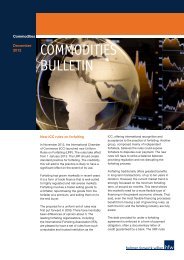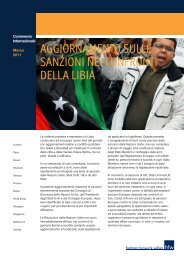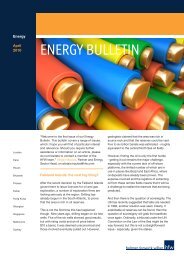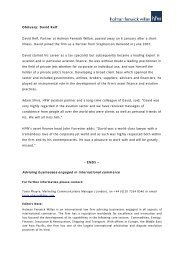GLOBAL GA - Holman Fenwick Willan
GLOBAL GA - Holman Fenwick Willan
GLOBAL GA - Holman Fenwick Willan
You also want an ePaper? Increase the reach of your titles
YUMPU automatically turns print PDFs into web optimized ePapers that Google loves.
Insurance Coverage: is your<br />
medical certificate still valid?<br />
In 2006 a Canadian pilot lost control of<br />
his Cessna 177B aircraft after making<br />
a slow-speed pass at low altitude.<br />
He obtained his private pilot license<br />
in 1993, but his most recent medical<br />
certificate expired in 2005.<br />
His estate submitted a $60,000<br />
insurance claim for damage to the<br />
aircraft. However, the aviation insurer<br />
denied the claim on the ground that<br />
the policy “applies only if your aircraft<br />
is flown by an approved pilot…who<br />
has the required license...to fly”.<br />
Subsequently, the estate issued legal<br />
proceedings against the Insurer.<br />
At first instance the estate succeeded in<br />
its claim, with the Master of the Alberta<br />
Court of Queen’s Bench finding that the<br />
language of the policy was ambiguous<br />
and that the policy only required that<br />
the pilot had a license to fly an aircraft<br />
without additional requirements. This<br />
decision was then overturned on<br />
appeal, the judge ruling that a “required<br />
license” under the policy meant a<br />
license that was valid. It found that it<br />
would stretch “the bounds of common<br />
sense to find that an invalid license<br />
is still a license and that insurance<br />
coverage is valid”. Finally, in January<br />
2012, after hearing an appeal by the<br />
estate, the Alberta Court of Appeal<br />
held that the policy was not ambiguous<br />
and that the insurer was entitled to<br />
deny coverage. The Court ruled that<br />
reference to a license means a license<br />
in force and since the pilot did not have<br />
an up-to-date medical certificate his<br />
license had also expired.<br />
For more information, please contact<br />
Peter Coles, Partner, on +852 3983<br />
7711 or peter.coles@hfw.com, or your<br />
usual contact at HFW.<br />
04 General Aviation Bulletin<br />
The Italian government<br />
appears to have heeded<br />
industry concerns and has<br />
modified a new tax on private<br />
aircraft<br />
The latest Italian “luxury tax”,<br />
approved in December 2011, was<br />
to be levied on a sliding scale from<br />
€1.5 per kilogram per year for aircraft<br />
under 1,000 kgs, to €7.55 per kg for<br />
aircraft over 10,000 kg. Helicopters<br />
were to pay double these rates. What<br />
concerned the international aviation<br />
community however was that the<br />
new levy was originally proposed<br />
to be applied to any private aircraft,<br />
regardless of nationality, which<br />
remained on Italian territory for 48<br />
hours or more.<br />
In response to these concerns,<br />
amendments to the legislation,<br />
passed this April, extend the period<br />
in which non-Italian registered aircraft<br />
can spend in the country to 45<br />
consecutive days 1 . Any time spent in<br />
maintenance facilities on Italian soil<br />
will not count towards the 45 day<br />
allowance. After the 45 day period<br />
the tax will be applied on a pro-rated<br />
monthly basis.<br />
Other amendments made to the new<br />
tax include a 50 per cent reduction in<br />
the rates for aircraft below 6000 kg<br />
and in those applying to helicopters.<br />
The new rates are as follows:<br />
Aircraft Maximum Takeoff Weight (MTOW)<br />
Up to 1,000 kg (2,200 lb)<br />
Up to 2,000 kg (4,400 lb)<br />
Up to 4,000 kg (8,800 lb)<br />
Up to 6,000 kg (13,220 lb)<br />
Up to 8,000 kg (17,600 lb)<br />
Up to 10,000 kg (22,000 lb)<br />
Up to 22,000 kg (22,000 lb)<br />
1. The amended tax regime has a retroactive effective date<br />
of 6 December 2011 for Italian registered aircraft and 28<br />
December 2011 for non-Italian registered aircraft.<br />
The amendments also created a new<br />
“user fee” tax on chartered flights<br />
at the rate of €100 per passenger<br />
for flights of less that 1500km and<br />
€200 on all longer flights. This tax<br />
is payable by the charter operators<br />
and is likely erode their profitability<br />
whether they decide to pass it on to<br />
their passengers or not.<br />
The recent changes to the scheme<br />
seem to meet industry concerns but<br />
only half way. Whilst they do away<br />
with the most controversial aspect<br />
of this tax, namely the exposure of<br />
persons with no connection to Italy to<br />
significant tax bills in circumstances<br />
that are out of their control - e.g.<br />
weather delay, a mechanical problem,<br />
or industrial action by ATC - key<br />
aspects of the tax, such as whether<br />
it should be levied progressively,<br />
remain unclear. It is also unclear<br />
if this form of “tax of the rich” will<br />
be emulated by other European<br />
Governments as the Eurozone crisis<br />
deepens, and, if so, in what form.<br />
For more information, please contact<br />
Zohar Zik, Consultant, on +44 (0)20<br />
7264 8251 or zohar.zik@hfw.com, or<br />
your usual contact at HFW.<br />
Tax Rate (€)<br />
0.75 per kg<br />
1.25 per kg<br />
4.00 per kg<br />
5.00 per kg<br />
6.65 per kg<br />
7.10 per kg<br />
7.55 per kg

















